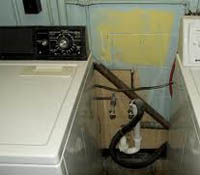Washing Machine Drainage
If you have a washing machine drainage problem in your home, it's important to understand that there are multiple causes for this type of issue. Before you try to fix your washing machine drainage problem, make sure you identify exactly what's causing it.
Is Your Washing Machine Overflowing?
A common drainage problem is that a washing machine will overflow when it’s supposed to dump the water inside of it. If this is your problem, you've probably found that in order for the water to clear, you have to stop your machine several times. A common mistake that homeowners with this problem make is trying to use muriatic acid to clear the blockage. In reality, you should never use acid on a drain line that's made from metal. Better options are Liquid Plumber or Drano. However, keep in mind that these products can be dangerous to humans, so be cautious when using them.
While either of those lye-based products can break up a clog, your washing machine drainage problem may not be the result of a clog. Instead, it may be the result of roots breaking through your pipes. If that's the case, solving your problem will require removing the roots and then installing new piping. Because both of these tasks are quite complex, you will want to enlist the help of a professional. This type of drainage problem can also be caused if a machine doesn't have a vent. In this situation, you'll need to use a strong adhesive to connect the machine's drain hose to its pipe.
Should You Change to a Different Washing Machine?
Many older homes have tub type washing machines. While a lot of homeowners have grown used to using their older washing machine, they don't realize that it may be at the root of their drainage problems. The reason the machine itself can cause everything from flooding in a utility room to water backing up through other drains in your home is because of the large amount of water that this type of machine uses. By switching to a more modern front loading machine, you can not only eliminate your drainage problem, but also:
- Save money by using less water
- Allow your clothes to last longer thanks to gentler washing
- Save money by using less heat to warm the water
What Happens If Overflows Lead to a Wall Rotting?
If your washing machine repeatedly overflows, there is a good chance the wall behind it will start to rot. If this occurs, you'll have no choice but to tear out the wall and replace it. However, it's important to remember that replacing the wall doesn't mean you've fixed the actual drainage problem. In many cases, this type of drainage issue occurs from an air lock in the pipe. If this is what's causing your washing machine drainage problem, you will need to add a vent to the pipe to fix it. Once your pipe is vented, air will no longer get trapped in it and cause flooding.

